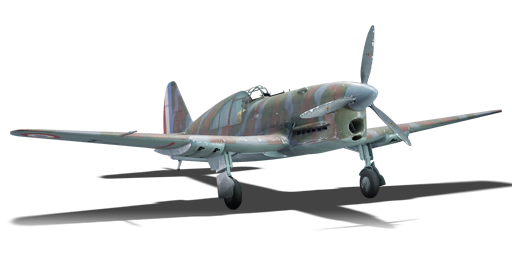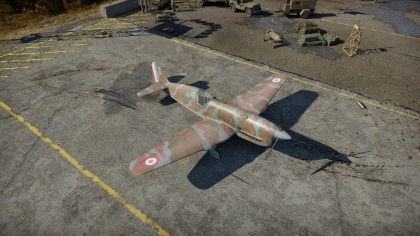C.R.714
Contents
Description
The C.R.714 is a rank I French fighter
with a battle rating of 1.3 (AB/RB/SB). It was introduced in Update 1.73 "Vive la France".
The C.R.714 is a good transition for new pilots going from biplanes to mono-wing aircraft. Like many aircraft which are mono-wing (light Japanese aircraft excepted), they are heavier than biplanes leading to a poorer turning radius in comparison. Alternatively, newer mono-wing aircraft tended to utilize larger engines and were capable of more power. The C.R.714 initially was developed as a race plane and excels when it is allowed to remain at speed, however if forced into a turning battle, it will lose speed rapidly.
General info
Flight performance
The C.R. 714's flight characteristics are relatively unsurprising given it's racing heritage. The plane has good acceleration and a mediocre climb rate. It's manuveurability is quite bad, which is to be expected from an early monoplane fighters. The plane has a decent roll rate, but a rather lacklustre turn time when compared to the aircraft it commonly faces in battle. However, this can be remedied through effective use of the aircraft's rudder, as the aircraft's control surfaces are quite effective.
The plane's engine is quite reliable, and can handle WEP for almost infinitely at higher altitudes. As well, note that the engine will experience fuel starvation when flown upside-down. However, the main limiting factor of the aircraft's performance is its top speed - the aircraft can only attain ~375 kph at low altitudes and ~450 at higher altitudes. This means that it will barely be able to outspeed some faster biplanes at it's tier. This can be remedied as the aircraft is quite structurally sound, and can manage dives of 650 kph without issue. However, not that the ailerons tend to lock up past 500 kph so the aircraft has very limited roll ability in dives.
| Characteristics | Max Speed (km/h at 4,500 m) |
Max altitude (metres) |
Turn time (seconds) |
Rate of climb (metres/second) |
Take-off run (metres) | |||
|---|---|---|---|---|---|---|---|---|
| AB | RB | AB | RB | AB | RB | |||
| Stock | 460 | 446 | 6000 | 21.2 | 22.0 | 6.5 | 6.5 | 200 |
| Upgraded | 516 | 487 | 18.9 | 20.0 | 13.1 | 9.3 | ||
Details
| Features | ||||
|---|---|---|---|---|
| Combat flaps | Take-off flaps | Landing flaps | Air brakes | Arrestor gear |
| ✓ | ✓ | ✓ | X | X |
| Limits | ||||||
|---|---|---|---|---|---|---|
| Wings (km/h) | Gear (km/h) | Flaps (km/h) | Max Static G | |||
| Combat | Take-off | Landing | + | - | ||
| 735 | 240 | 350 | 280 | 240 | ~11 | ~5 |
| Optimal velocities (km/h) | |||
|---|---|---|---|
| Ailerons | Rudder | Elevators | Radiator |
| < 280 | < 240 | < 420 | > 280 |
| Compressor (RB/SB) | ||
|---|---|---|
| Setting 1 | ||
| Optimal altitude | 100% Engine power | WEP Engine power |
| 4,000 m | 456 hp | 585 hp |
Survivability and armour
- No armour plating on aircraft
- Self-sealing fuel tank located between engine and pilot
Modifications and economy
Armaments
Offensive armament
The C.R.714 is armed with:
- 4 x 7.5 mm MAC 1934 machine guns, wing-mounted (300 rpg = 1,200 total)
The four machine guns are arranged in bundles of two mounted in the wing. Each are armed with the same amount of ammunition, which means that all guns will fire together until empty.
Usage in battles
The C.R.714's racing heritage heavily influences the play style for this aircraft: Boom and Zoom. Spend the first portion of the match climbing to altitude, then locate a suitable target and dive on them. However, it would be a wise choice to prioritize slower, bulkier targets as the plane's ailerons will make it impossible to change course at high speeds. Simply dive in, fire a burst, then climb out. If the enemy manuveurs to prevent you from shooting them, simply pull up and disengage back to a higher altitude. Don't over-engage as it will mean that you will lose your speed advantage, and potentially force you into a turn fight. Do not engage in a turn fight! Most of all of other fighters you will face will have a tighter turning radius and will easily find themselves right behind you.
The C.R.714 is a fairly responsive aircraft and while it may not be the best turn fighter, if you are caught in a turn/looping fight, utilize the strong rudder to aid in making sharper turns. Many times, utilizing the rudder will throw off the trajectory of your aircraft making it more difficult for a pursuing aircraft to get accurate gun fire on you. However, the best defence to this is to simply not get caught in a turn fight - most of the time, the aircraft will not fair well in extended turns, and will quickly be sent back to the hangar.
Specific enemies worth noting:
- I-15 and I-153 M62: The Chaika family of biplanes are a destructive set of enemies often encountered at your BR. The earlier models possess an extreme level of manuveurability, while later models have a strong top speed almost as good as your's. The best strategy to resort to is to simply Boom & Zoom on them while they're occupied or in a dogfight. Their airframes are fragile and won't take many hits from your 7.5mm MGs.
- Bf 109 / Re. 2000: These two aircraft have been lumped together due to their similar characteristics. Both are faster than you, and will beat you in a speed battle. The best way to engage these aircraft is to have an altitude advantage and B & Z them when they're not paying attention or occupied. If one tries to dive on you, turn outwards and force them to disengage.
- Other reserve aircraft / early biplanes: This category includes the P-26, He 51, Fury and other low-tier aircraft. They all have lower top speeds than you, meaning that you can B & Z them without much issue. As well, their airframes are practically made of paper, so a few shots will be enough to send them back to the hangar.
Manual Engine Control
| MEC elements | ||||||
|---|---|---|---|---|---|---|
| Mixer | Pitch | Radiator | Supercharger | Turbocharger | ||
| Oil | Water | Type | ||||
| Controllable | Controllable Not auto controlled |
Controllable Not auto controlled |
Not controllable Not auto controlled |
Separate | Not controllable 1 gear |
Not controllable |
Modules
| Tier | Flight performance | Survivability | Weaponry | |
|---|---|---|---|---|
| I | Fuselage repair | Radiator | Offensive 7 mm | |
| II | Compressor | Airframe | New 7 mm MGs | |
| III | Wings repair | Engine | ||
| IV | Engine injection | Cover | ||
Pros and cons
Pros:
- Great roll rate
- Decent level speed
- Machine guns are quite powerful (~25 rounds per second per gun)
- Small target
- Slightly better climb rate than average
- One of the best rank 1 Boom and Zoom/energy fighters
- Excellent cockpit visibility
Cons:
- Machine guns jam between 6 - 10 seconds of continuous fire
- Average turn radius (almost catches smoke trail in turn)
- Low ammunition count
- Can be difficult to master for early players still learning the game
History
The C.R. 714 "Cyclone" was the final variant of the C.R. 710 aircraft family developed by Caudron-Renault aircraft, designed as a wooden light fighter capable of boosting the inventory of the French Air Force. The aircraft was improved over the original C.R. 710 through a strengthened airframe, redesigned wing, and new engine that is able to handle negative G loads. The aircaft also had it's armament changed from twin 20mm Hispano 404 cannons to four 7.5mm machine guns. The Air Ministry ordered 20 C.R. 714 aircraft in November of 1938, along with options for 180 more aircraft.
Deliveries of the aircraft began in January of 1940. By that time, it was very apparent that the aircraft had serious design flaws: importantly, the wooden airframe prevented the installation of a more powerful engine. The insufficient engine power of the C.R. 714 limited it's performance so much that it was withdrawn from active duty. Subsequently, the order total was reduced to 90 aircraft, 80 of them intended to be diverted to Finland to fight in the Winter War.
However, a series of events resulted in only six aircraft being delivered to Finland, and they didn't see active service as the Finnish personnel deemed the aircraft too dangerous to operate in winter conditions. Thus, 35 Cyclones ended up being delivered to the Polish Warsaw squadron, based in Lyon. Soon after, pilot opinion confirmed that the underpowered aircraft was no match for the Bf-109Es they commonly encountered over French airspace.
As there were no other options, the Polish pilots flew the C.R. 714 for the remainder of the Battle of France. Despite the oblescence of their aircraft, they still managed to shoot down 12 German aircraft, with losses of 9 in the air and 9 on the ground. By the end of June, when France fell, only 53 C.R. 714s had been completed, and the remaining airframes were quickly retired.
Media
See also
Links to the articles on the War Thunder Wiki that you think will be useful for the reader, for example:
- reference to the series of the aircraft;
- links to approximate analogues of other nations and research trees.
External links
| Caudron Aircraft Society (Société des Avions Caudron) | |
|---|---|
| Fighters | C.R.714 |
| France fighters | |
|---|---|
| Dewoitine | D.371 · D.371 H.S.9 · D.373 · D.500 · D.501 · Pallier's D.510 · D.520 |
| Morane-Saulnier | M.S.405C1 · M.S.406C1 · M.S.410 |
| Arsenal | V.G.33C-1 |
| Bloch | M.B.152C1 · M.B.157 |
| Caudron | C.R.714 |
| Sud-Ouest | S.O.8000 Narval |
| American | H-75A-1 · H-75A-4 · ▄P-39Q-25 · ▄P-40F-5 Lafayette · ▄P-47D-22-RE · ▄P-63C-5 · F-6C-10-NA |
| ▄F6F-5 · ▄F6F-5N · F4U-7 · ▄F8F-1B | |
| Other countries | ▄Seafire LF Mk.III · ▄Yak-3 · Challe's ▄Yak-9T · NC.900 |
| Belgium | ▄Gladiator Mk I · ▄Spitfire FR Mk XIVe |
| Netherlands | ◘Sea Fury FB 51 |





